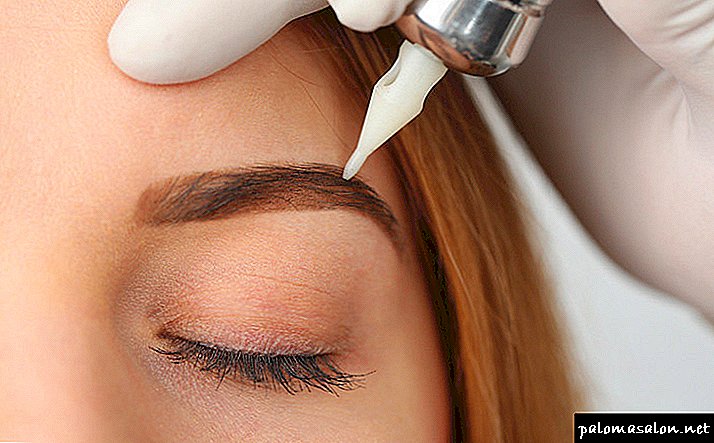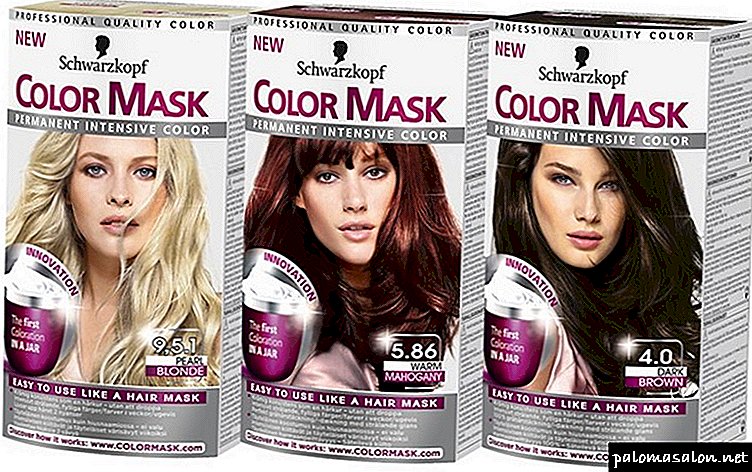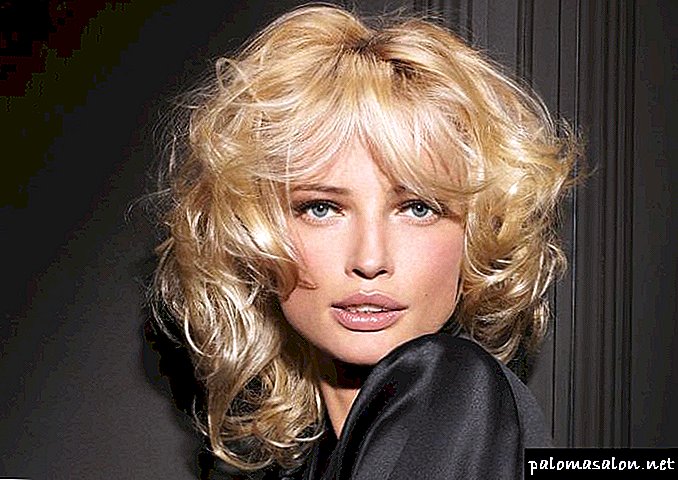Nits called this type of parasite, as the eggs of lice. It is a small capsule, which is located in a special shell of adhesive substance, which ensures perfect fixation on the hair.

Capsules are deposited by sexually mature female lice, which can make several clutches in one day.
We recommend reading: the life cycle of the development of head lice and nits.
How does it look
Have a very small size. Externally similar to small capsules, usually white in color, slightly transparent. The capsule shape is elongated. Quite often, the appearance of nits can be confused with dandruff. Capsules can be relatively easy to see what to do on dark hair at times easier.
With this parasite, the hair does not look clean - there is a feeling that they are greasy, dirty and not combed for a long time. Taurus length about 0.7-0.8 mm long. When examining the parasite's little body through a microscope, one can notice a kind of tail, which is the attachment of the parasite to the hair. And also, in addition to the fastening, there is a valve, from where after a while a new individual will appear.
Attention! It is not so easy to distinguish the empty shell from the one in which the larva is still developing. Dry nits remain on the hair until they fall out, provided they are not removed with the help of specialized tools. Because of this fact, many people think that the number of nits exceeds the number of lice. How to distinguish the dead from the living nits, you will find on our website.
What do head lice look like - photo, treatment, prevention. Where lice come from
Pediculosis is a parasitic disease caused by lice. Lice can be of three varieties - head louse, body louse and pubic louse. The problem of pediculosis in modern times has not lost its relevance.
It is also easy to catch pediculosis, using bed linen in trains, in the bath or sauna. In most cases, head lice caused by head lice.
What do parasites look like?
Many are concerned about how the head lice looks. Lice move very quickly (speed 23 cm per minute), it is difficult to notice.
- The insect has a grayish or whitish color, its length is about 2-3 millimeters, has 6 legs.
- It is much easier to notice the lice eggs - nits, head lice lay them in huge quantities.
- Nits have a yellowish-white color and tightly attached to the hair (0.7 cm from the skin), they can not shake off like dandruff or sand.
- They have a small size, not more than 1.5 millimeters.
- Lice and nits are usually found on the scalp, but can sometimes be on the eyebrows or eyelashes.
The life cycle of a head louse (life expectancy) is 3 weeks; outside the head, an insect can live no more than a day, nits 2 weeks.
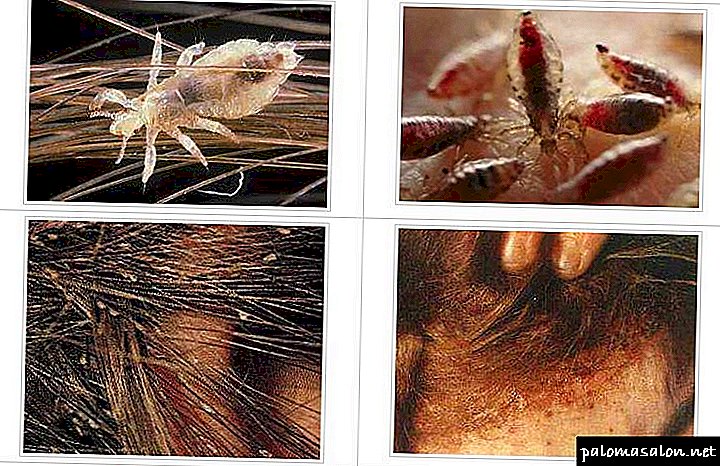 What do head lice look like
What do head lice look like
Lice feed only on blood, itching of the scalp develops approximately 2-4 weeks after infection and is caused by the fact that when the skin is punctured, the lice emit saliva.
Signs of head lice
The following symptoms of pediculosis can be distinguished:

Itching - The most noticeable of head lice symptoms. It can spread almost all over the head, but its appearance does not occur during bites, but somewhat later.
This is explained by the fact that the jaws of the lice are very small, so their penetration through the skin is quite difficult to feel right away.
In addition, before you begin to suck blood, insects inject their saliva, which consists of painkillers.
Directly the body’s response to them becomes cause itching and discomfort. Bites. Their appearance can be noticeable all over the head, in particular on the hair, in the area of the neck and ears.
In advanced and very severe stages of pediculosis, small areas that have undergone multiple bites can be combined into fairly wide zones that can cover almost the entire head. Tissue infection, which arose with a huge number of bites and strong combs. Most skin infections are observed in the form of open wounds or purulent swelling.
In most cases, similar signs of pediculosis in adults and children appear on very sensitive areas of the skin - at the back of the head and ear area. With prolonged pediculosis, signs of lice on a person’s head may appear, such as skin seals, as well as slight engorgement.
This is due to the fact that during healing, normal tissues are replaced by connective tissues, which are inherently more rigid and do not differ in their particular elasticity.
The appearance of parasites
Distinguishing these parasites from other insects will not be particularly difficult if you have an idea about the appearance and symptoms of lice in adults and children.
In addition, they almost transparent, in some cases have a gray or light brown color. And only after the lice eat human blood, their body becomes burgundy or red-brown in color. Also, after eating food insect size may increase.
The louse body itself has three parts - this head, chest and belly. The head is not large, there are antennae on it.
On the sides of the thoracic region are three pairs of legs, the length of which is approximately the same. The widest part of the body of lice is the abdomen., especially its noticeable expansion is observed at the end.
These photos show lice in the hair and the symptoms of their appearance:
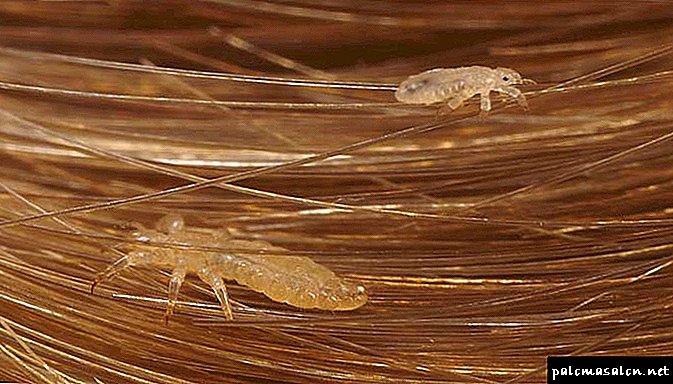
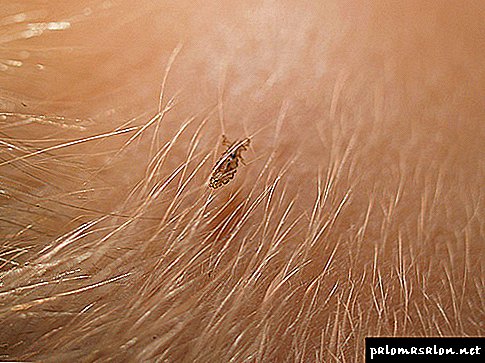

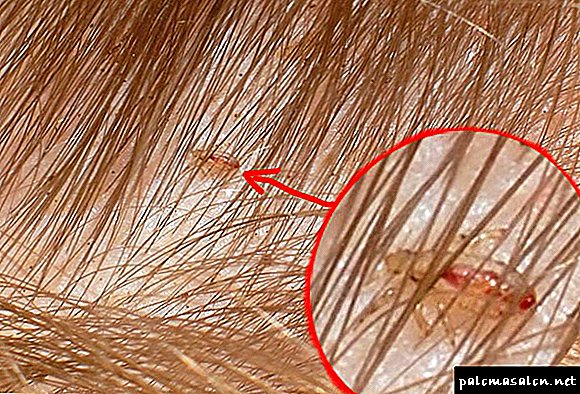
What the nits look like
With the naked eye it is very difficult to discern the appearance of louse eggs, and sometimes it is quite problematic to identify them right away. This is explained by nits are microscopic in sizethat reach 0.8 millimeters.
However, when examining the hair with a microscope, you can see that the appearance of the nits looks like an elongated capsule - one side of it has a mount, firmly enveloping the hair, and the other is equipped with an analogue of a flat cap through which a ready larva appears.
Due to the fact that a detailed inspection of nits is possible only with the help of magnification, should be able to recognize it and to the naked eye.
Obvious symptoms of pediculosis in adults and children - the appearance of nits - are presented in these photos:
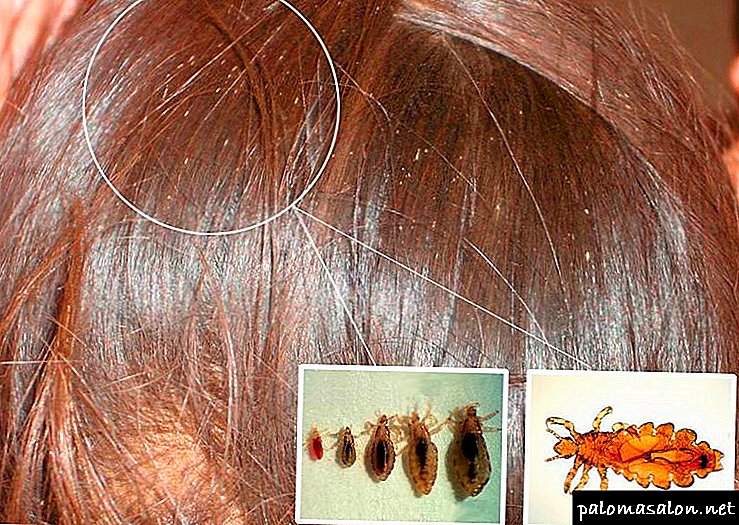


Bite locations
Lice bites to detect are no particular problems, as they resemble flea bites - after them appear small dots of red color with a lingering central part. This is one of the most noticeable symptoms of lice in humans.
In most cases the bite site is subject to inflammation, and the point itself is visible even with the naked eye.
After bites very skin irritation often occurswhich many people perceive as a common allergic reaction.
These photos show such signs of lice in the head as their bites:



The first symptoms of the disease
The very first sign of pediculosis is the appearance of small wounds - traces of parasite bites. In particular, quite often they can be seen in the occipital and temporal regions, as well as near the ears.
In some cases, the bitten place is exposed to infection, which is accompanied not only by deviations in the state of the skin surface, but also by the appearance of a new sign of lice in a person - lymph node swelling.
In addition, if a person neglects the rules of personal hygiene, eggs and lice release cause enough unpleasant smell and tangle of hair. This causes more nits to be deposited and, consequently, faster reproduction of the parasites.
Also, do not run the treatment process - the disease can spread quite quickly, both in a family circle, and among other people.
What do head lice look like?
Many are concerned about how the head lice looks. Lice move very quickly (speed 23 cm per minute), it is difficult to notice.
- The insect has a grayish or whitish color, its length is about 2-3 millimeters, has 6 legs.
- It is much easier to notice the lice eggs - nits, head lice lay them in huge quantities.
- Nits have a yellowish-white color and tightly attached to the hair (0.7 cm from the skin), they can not shake off like dandruff or sand.
- They have a small size, not more than 1.5 millimeters.
- Lice and nits are usually found on the scalp, but can sometimes be on the eyebrows or eyelashes.
- The life cycle of a head louse (life expectancy) is 3 weeks; outside the head, an insect can live no more than a day, nits 2 weeks.
- Lice feed only on blood, itching of the scalp develops approximately 2-4 weeks after infection and is caused by the fact that when the skin is punctured, the lice emit saliva.




Where lice come from - head lice causes
Where do head lice come from? Many have a misconception about how head lice are transmitted. Many people think that they jump or even fly. But it is not, these insects do not have wings for this.
- A human head louse is transmitted by direct contact.
- When using general hygiene items with a sick person (towel, bed linen, comb) or hats.
- Louse can run across the hair if there is contact, especially if it is long hair.
- There is an opinion that only antisocial people suffer from pediculosis, but this is not the case; ordinary people may have head lice, the causes and ways of transmission are so varied that any person can become infected.
- Places where pediculosis is most often infected are kindergartens, schools, summer camps, baths, saunas, swimming pools, hotels, trains, hairdressers.
Pediculosis is of great epidemiological significance. In the stomach of head lice there are favorable conditions for the growth and reproduction of certain microorganisms. These include causative agents of typhus and relapsing fever. These diseases are transmitted to humans not by a bite, as is commonly thought, the salivary glands and their secret do not contain typhoid pathogens. They are excreted with the excrement of head lice or when it is crushed. If the scalp is damaged, then typhoid fever will occur. Infection is also possible if the pathogen enters the mucous membranes or when rubbed into the skin.
Symptoms of Pediculosis
The first clinical manifestations of the disease can be in a few weeks. Head louse gets to the new owner, attached to the hair. For reproduction, it needs food. It feeds on blood, piercing the skin with a proboscis. In places of a sting small spots can remain, also in these places the itch appears. Then the female starts laying eggs. They are attached tightly to the hair, so they are not washed off during normal shampooing. A few days later, young lice appear from them.
The main symptom of pediculosis is itching in the affected area. Itching is most pronounced in the occipital region, in the temples and behind the auricles. Accompanied by a disease of decreased appetite and sleep disorders.
On examination of the scalp visible damaged skin with yellow crusts. There may be signs of inflammation of the hair follicles - folliculitis. In places of greatest accumulation of head lice (behind the ears, on the temples and on the back of the head) there are changes characteristic of eczema. On examination, you can see nits. Empty nits have a grayish color. Complete nits are white or yellowish. When they are crushed between the nails will click.
In neglected cases, the hair on the head is glued together and ticks are formed from the hair. When scratching the scalp, often the course of the disease is complicated by furunculosis of the scalp or other pustular lesions. If untreated, lymphadenitis develops, and the cervical and behind-the-ear lymph nodes become enlarged and inflamed.


How to remove head lice - how to treat pediculosis?
Previously, when detecting head lice treatment was applied ineffective. Common methods of treatment were kerosene, tar soap, dichlorvos, vinegar or cranberry juice. We strongly recommend against using all these methods.
On the pharmaceutical market are various tools for the treatment of head lice. They are in the form of sprays and shampoos (see the most complete overview of all lice shampoos and a guide with instructions, prices and reviews). The most common remedies include:
- The safest and most effective means are oils, odorless - Full Marks (450 rub), D-95 emulsion (about 200 rub)
- Chemerichnaya water
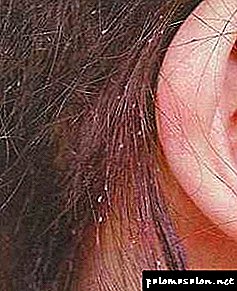
- Malathion Shampoo - Pedilin
- Preparations of permethrin, for example, Nittifor, Knicks, Medifox concentrate for the preparation of an emulsion of 5%, Medifox-pediculicidal gel, Hygia, Veda 2.
- Preparations on benzyl benzoate, for example, Foksilon lotion.
- Phenotrin - Parazidoz Shampoo
- Mineral oils - Paranit shampoo
The choice of the drug for treatment is carried out by a dermatologist. Before using any of the drugs, you must carefully read the instructions, strictly follow it. All of these drugs are toxic. They have a huge number of contraindications, most of these tools can not be used in pregnant women, young children, allergies or people with pathologies of the respiratory tract (see how to get rid of lice in a child).
After applying these tools, it is necessary to comb the hair with a metal comb. The teeth of the comb should be very rare. So how to get rid of head lice and nits is difficult and not all of them die during the processing means. You can remove the nits with your hands, but it will take much more time. Plastic combs can not separate the nits from the hair shaft. To facilitate the removal of nits with a comb, olive oil can be applied to the hair. It also has anti-inflammatory and wound-healing effects.
Important! After chemical treatment for the next 2 days, do not wash your hair with shampoo. And also should not use air conditioners, hair balms (2 weeks), because they create a film and prevents the penetration of permethrin and other substances. If you avoid the use of toxic substances or the child is very small, you can comb nits and louses for 1, 5, 9, 13 days, abundantly apply hair conditioner and carefully comb each strand with a frequent comb (see the effectiveness of combing with conditioner for head lice). That is, to use for removing head lice or chemical equipment, or air conditioning.
Many people think that you need to shorten long hair. It is not necessary to do this, since the nits are located at the roots of the hair, not more than 5 centimeters from the surface of the head.
After treatment, a person cannot visit crowded places (school, kindergarten, theater, cinema) for two weeks.
Since lice do not live outside the head for more than 1 day, the probability of re-infection is not great, but it is there, so you should:
- After processing the head, do a general cleaning in the baby’s room.
- Wash bedding and clothes in which an infected person has been walking for the last 2 days (54 ° C is the temperature in which both nits and louses die in five minutes).
- It should also disinfect all combs, barrettes - to do this for 1 hour should be placed in water with a shampoo for lice, or in an alcohol solution.Or rinse thoroughly with small and put in a package for 2 days in the freezer.
- Things that cannot be washed — hats, coats, etc., can either be dry-cleaned or simply packed in bags for 14 days — during this time the nits will die.
Pediculosis prevention
You must always follow the rules of personal hygiene, monitor the condition of the hair. Holders of long hair in public transport is better to remove the hair under the clothes or collect them in the tail. Never use someone else's hairbrushes, hair ties or hairpins. Do not use other people's hygiene items, towels. Do not sleep on bedding on the train, it is better to take from home with you. Do not wear other people's hats.
If someone has found this parasitic disease in your family, then instead of treating the patient, measures should be taken to prevent the spread of lice.
It is necessary to boil and iron pillows, pillowcases, sheets, towels, headdresses of the patient. Warn all contact persons (children in kindergarten or school, relatives), be examined by a dermatologist.
The concept of nits and causes
Nits don't come by themselves. It is impossible to get infected by them. The occurrence of pediculosis begins with the relocation of adult lice on the head of a person. This individual lives on people's hair and feeds on their blood. This insect breeds by laying eggs. An adult individual reaches from 3 (male) to 4 mm (female) in length. She is able to lay 5 eggs per day. For a month from one louse may appear up to two hundred nits. Accordingly, the reproduction of these insects on the heads of people is happening rapidly.

An adult louse sticks eggs in the hair at some distance from the skin with the help of a sticky substance that is very strong. It is easier to pull out the hair with a laid egg than to separate the nits from it. The ideal temperature at which nits in hair ripen is up to 30 degrees. After seven to ten days, the larva leaves the egg, and a week later it turns into an adult individual capable of breeding.
Especially often the problem occurs in a child under 12 years. This is explained by the fact that children do not immediately attract the attention of adults. Attending children’s institutions (kindergartens and schools) also leads to the spread of the disease. Children closely communicate with each other, play together. They often try on each other's hats, which is not typical of all adults.
However, infection with pediculosis is also possible at an older age. Pediculosis affects half the population during their lifetime. The head at the same time looks extremely untidy. Unwashed head is not considered the cause of nits and lice. They prefer to settle in clean heads to make it easier to eat.
Symptoms of nits and lice
Very often, parents do not immediately notice the appearance of nits in children. Often, small white or yellowish oval eggs are mistaken for dandruff. And the fact that the child begins to itch, is associated with poorly chosen shampoo or dirty head. Only experienced mothers and grandmothers, as well as medical workers, distinguish head lice from all other problems. The main signs of the appearance of lice and nits are considered:
- the presence of itching (especially when washed head),
- detection of adults and nits (not to be confused with dandruff),
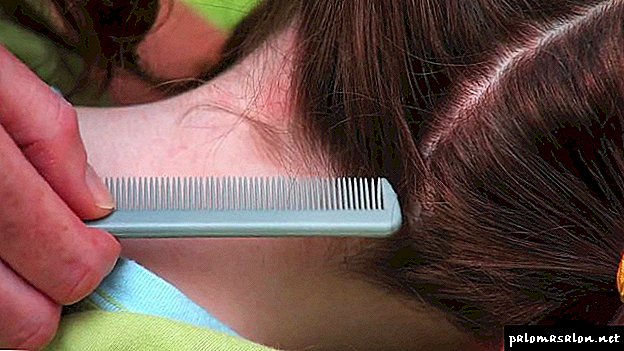
- small wounds on the skin from biting lice,
- peeling in some areas of the head (on the back of the head, temples, behind the ears),
- poor appetite
- general irritability of a person
- swollen lymph nodes
- disturbed sleep, insomnia.
Tip!If a child has some of these symptoms, immediately inspect the head, try to comb it. The likelihood of a child biting lice is very high.
All these symptoms should be extremely alert the person. If adults are found. That is, in the presence of their eggs. Dandruff at the slightest whiff of hair flies from the head.
She showered with shaking. Nits in the hair remain. They are harder to get rid of than lice.
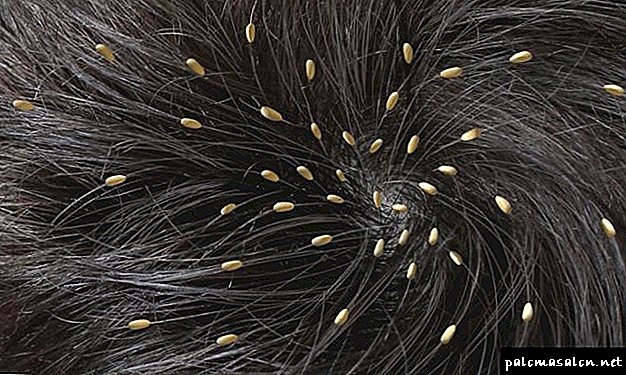
The danger of the presence of nits and lice in human hair
Settling in human hair, these insects and their eggs can cause a lot of trouble. Main diseases caused by head lice:
- Allergy, as a result of lice getting biological wounds,
- Eczema,
- Dermatitis,
- Pus on the skin,
- Blepharitis eyes,
- Relapsing fever,
- Pigmentation of the scalp with advanced forms.
Lice must be removed immediately. From nits have to get rid of more than one week.
Options for getting rid of nits and lice
To get rid of nits and lice, you can use some proven methods. As with other diseases, various options are offered:
- Getting rid of hair by shaving the head,
- Regular brushing,
- Use of pharmaceutical preparations,
- The use of folk methods.
Each of these ways of getting rid of the problem has proven itself in the proper way. However, a regular and reasonable combination of these techniques will show the most effective result in the fight against nits and lice.

Shaving the head as a measure for the treatment of pediculosis
To get rid of nits and lice on the head is the easiest way to do this. Nits are mounted on the hair. When cutting a hair, you can completely remove both nits and lice from the head irretrievably. Lice will not hide on anything, eggs - to fasten. After shaving the head it is necessary to observe all precautions. All shaved hair will have to be burned, and clothes and bedding should be washed at a temperature of at least 50 degrees. It is important to ensure that nits do not fall on the person who carries out the treatment. They are able to live outside the human body for several days.
Combing nits and lice out of hair
If the child is small or it is a boy - the problem is solvable. And how to be the owner of long hair? For them, combing with a special comb is effective. At the moment there are many varieties of such devices. The easiest comb can be bought at stores selling hair accessories or at pharmacies. Their teeth are located at a very close distance from each other. Bilateral comb can comb the whole family. If desired, and financial opportunities, you can purchase expensive electronic combs that act on the louse impulses. The problem with lice is solved. However, it should be remembered that such a combing does not help to remove the eggs. To get rid of them will help the integrated use of regular combing and various drugs and solutions.

In order to remove the eggs from the head, it is necessary to remove the females and males. Pharmaceuticals are divided into poisonous (insecticidal) and suffocating (lice). They come in the form of aerosols, creams, shampoos, lotions. Some of them have the ability to dissolve the sticky substance nits. But such preparations do not work on the eggs themselves. Nits are attached to the hair on a special strong solution. It must be neutralized.
If the product contains poison, there is a possibility of death and eggs. After using this drug, dead nits should be combed out. However, for a child or a pregnant woman, these drugs can be dangerous. They can cause intoxication and an allergic attack. Therefore, their use should be approached with extreme caution.
Some drugs act on the respiratory system of lice and suffocate them. These drugs are not so dangerous to health. Mothers, as a rule, prefer to buy such products. But they also do not affect the nits, but simply help to remove them from the hair.
If head lice occurs in an adult girl or woman, she often prefers to remove lice and nits using hair dye. Hair dye acts on nits and lice as a strong poison. And if the hair is dyed often, then the probability of infection is removed. In addition, the peeling of the scalp after applying a tool such as paint, prevents lice from feeding. For a child, the paint is not suitable because of its insecurity to the scalp and respiratory organs.
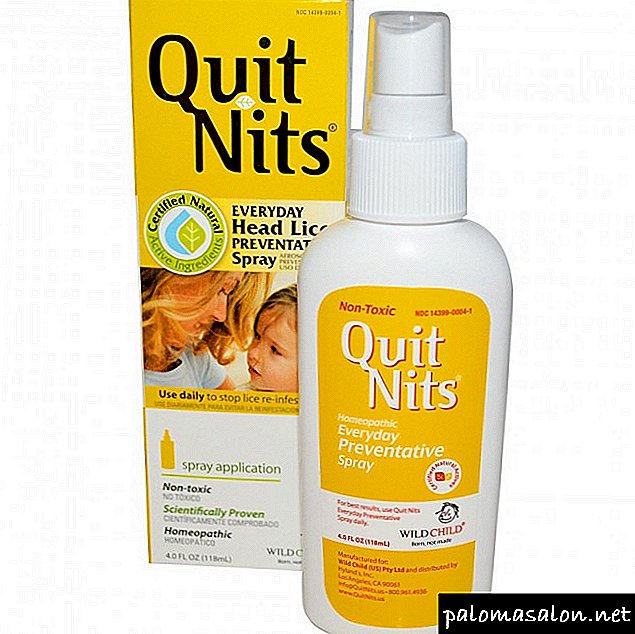
The use of popular recipes
Traditional methods tend to aim to get rid of eggs and lice at the same time. The huge variety of budget and expensive options for dealing with head lice allows you to choose suitable or combine their use.
Tip!Do not use aggressive methods of killing nits and lice every day. There should be a few days between treatments. But comb nits can and even need daily.
Suggested options for acting on eggs:
- Vinegar, vodka,
- Vegetable and essential oils, fats and ointments,
- Tar soap,
- Kerosene.
Vinegar or vodka is offered as a means of strangling lice and peeling nits. Remove the eggs becomes easier. Get rid of lice and nits with these drugs can be with regular use. Vodka is used by wetting it with a tampon or piece of cloth and rubbing it into the hair. Vinegar is diluted with water (1: 1, respectively). After an hour under the film, the head is washed and carefully combed over a bath or white sheet.

You can get rid of the problem with kerosene. It is diluted with vegetable oil 1:10 and rubbed into the hair for a long time. Nits this method also kills. Combing your hair helps remove dead lice and their eggs. This method is rightly called the most aggressive because of its high toxicity.
Essential and vegetable oils, various fats have a double effect in the fight against head lice. They help and remove lice, and easy to remove eggs. Any vegetable oil in which you can add a few drops of fragrant oils of mint, bergamot, tea tree and others, must be carefully rubbed into the hair for two hours. Oil inhibits insect respiration. After the procedure, half-dead lice and nits are easy to remove from the hair.
When treating pediculosis, it is important to devote time to the process of combing and treating the hair daily. This will help get rid of nits and lice within a month. This period is optimal for solving the problem.
How do they look visually?
 The size of the nits is very small - 1 mm in length and 0.5 mm in diameter. But thanks to its color (white, translucent), they can be easily detected on dark straight hair. On bright and curly hair, finding nits is more problematic, but with good vision it is possible.
The size of the nits is very small - 1 mm in length and 0.5 mm in diameter. But thanks to its color (white, translucent), they can be easily detected on dark straight hair. On bright and curly hair, finding nits is more problematic, but with good vision it is possible.
With a lot of nits, a person can confuse them with dandruff.
Features:
- Dandruff particles have different sizes, and nits are almost the same.
- Dandruff is very easy to chill with hair. In order to remove the nits from the hair, you need to make an effort: firmly squeeze it with your fingers and stretch it to the very end of the hair.
- Nit can be alive, if the larva has not left yet, then when you squeeze the capsule with your nails, you can hear a slight crunch.
Where are the nits on the man's head?
Lice are blood-sucking parasites, that is, they constantly feed on human blood. Each insect bites a person 3-4 times a day. Without blood, lice can last only two days, then they die.
Therefore, the female parasite, postpones its offspring, closer to the scalp, not higher than 1.5 - 2 cm from the base of the hair. This is done to ensure that after leaving the capsule, the young individual does not look for a source of food for a long time, but can immediately eat.
Nits are attached to the hairs with a special sticky substance that releases the louse along with the capsule. It hardens very quickly and becomes durable. Capsule as it covers the hair and glued to it.
This mount ensures the survival of the larvae, so nature has provided that the sticky substance does not dissolve with water. Procedures such as shampooing and frequent brushing are absolutely not scary for nits.
Even special remedies for pediculosis, which instantly kill a living louse, cannot penetrate the protective layer of the capsule and destroy the larva in the embryo. This can be done only by very toxic substances (dichlorvos, dust) or potent drugstores (Pair plus Pedilin).
Folk methods (cranberry juice and vinegar solution) corrode the sticky substance and weaken the nits attachment, but do not kill the larvae inside.
Photos of parasites on the hair

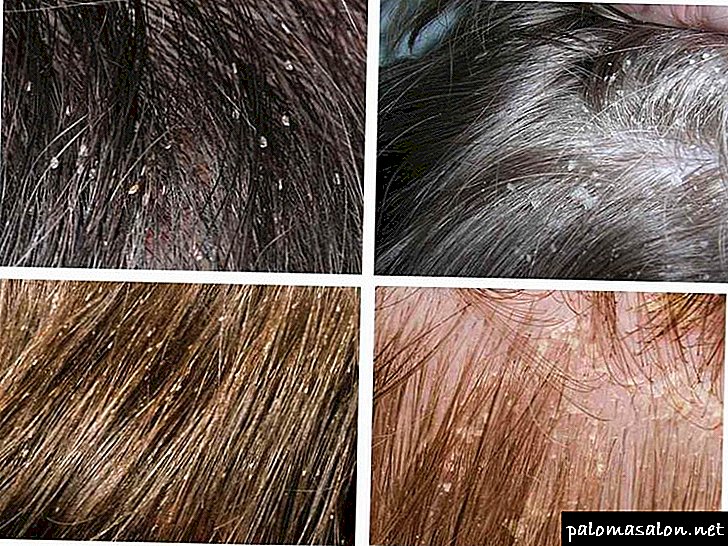
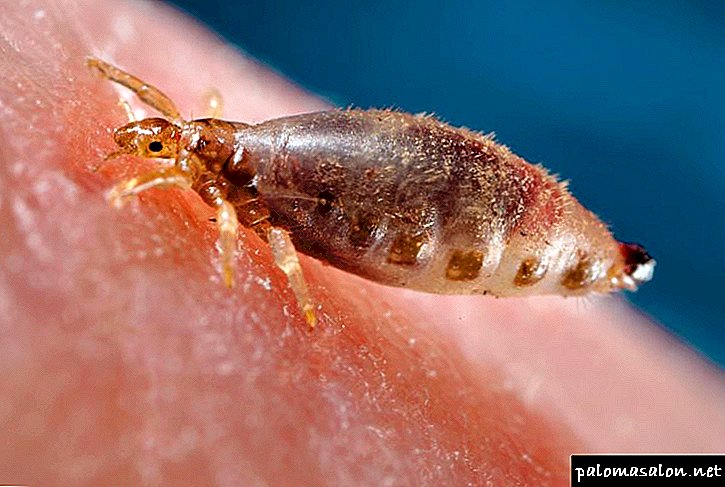

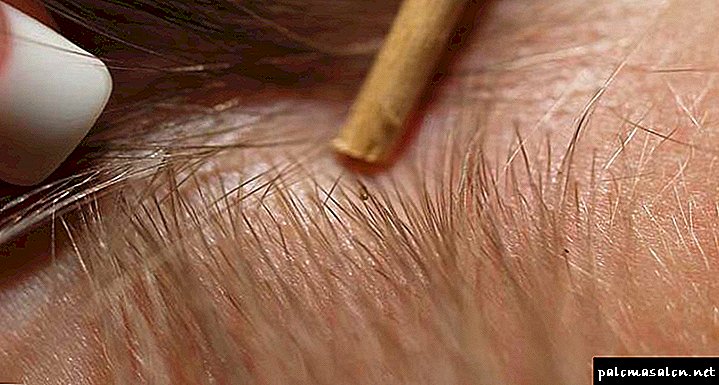
Lice under the microscope
Man with the naked eye is difficult to consider the detailed structure of the nits. But armed with a microscope, you can see a lot of interesting details, for example:
- The nit within which the larva is located has a non-solid structure, it is not like an egg. The thick edge of the capsule has a flat cap.
When the larva fully matures and is ready to leave its cocoon, the cap disappears or is pushed out by the larva itself. Each capsule is located on the hair in such a way that the cap looks down.
This was done to ensure that after the release of the young individual, it immediately fell on the scalp and could take the first portion of blood.
Live and dead nits
When detecting nits, it is very important to establish whether they are alive or dead. As new insects emerge from the living over time, the lice population will increase.
Signs of live nits:
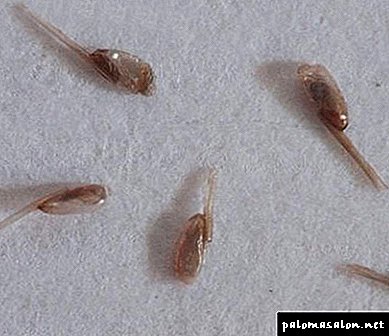 round shape, like a small ball,
round shape, like a small ball,- crackling when crushing the capsule between the nails.
Signs of dead nits:
- flat shape
- when pressing the nails on the capsule there is no sound.
Dead nits can show up if:
- the larva has grown and has already left its capsule
- after treatment of the head with an anti-pediculosis remedy, all the larvae were still nipped.
The attachment of the capsule to the hair is so great that even after the larva has matured and left the cocoon, it does not fall away from the hair, but continues to hang on it until the life cycle of the hair does not end and it does not fall out.
What if lice are found?
The presence of live capsules and severe itching of the scalp indicate pediculosis. And the sooner a person begins to fight with these parasites, the sooner he will win.
When detecting nits need:
- establish whether they are alive or dead.
- Treat the scalp and the entire head of hair with a means of pediculosis or a folk method.
- Daily thoroughly combing hair with a special comb, for 5-7 days.
- Then repeat the procedure of processing the head and again thoroughly comb through all the curls with a comb.
Useful video
The most effective and rapid results can be achieved by applying an integrated approach to solving the problem. Treatment of the head with a special tool (pharmacy or folk) will help get rid of living individuals, and combing hair with a comb helps to remove offspring. Completely get rid of nits - it is very important if at least one live larva remains on the head, then the lice population will grow very quickly.
How to identify lice in the head
Pediculosis of the human scalp appears due to infection with head lice. It is very easy to skip the onset of the disease, since it is quite difficult to detect these parasites on a person’s hair. This is understandable, because the size of the louse in length is not more than 4.8 mm.
A person can become infected with head lice at any age, however, girls and women suffer from this infection more often. The most frequent places of distribution This disease, which is often widespread, is:
- camps (especially in the summer),
- sanatoriums
- schools,
- kindergartens.
Lice infestation is carried out exclusively from person to person, as well as through personal belongings and hygiene items:
In an environment without a “carrier”, a head louse can live no more than two days.
Find out the time of infection lice, without exaggeration, speaking, it is impossible. This is because the obvious symptoms of head lice occur about a few weeks after infection. These include:
- severe, almost non-stop itching,
- nits, sometimes visible, in the hair,
- general feeling of discomfort in the scalp.
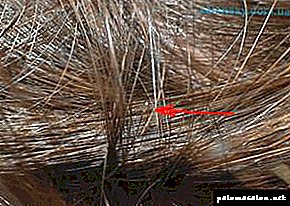 Mature individuals feed approximately 1 time per day (that is, only one bite occurs). Daily the female lays about 14 eggs (but no more). Larvae (nits) hatch from eggs no earlier than a week after laying. Being born, they also begin to feed on the blood of their host.
Mature individuals feed approximately 1 time per day (that is, only one bite occurs). Daily the female lays about 14 eggs (but no more). Larvae (nits) hatch from eggs no earlier than a week after laying. Being born, they also begin to feed on the blood of their host.
Accordingly, it takes at least a week from the moment the parasite penetrates to the hair until the appearance of obvious indicators of the disease.
Suspecting the presence of lice on the head is extremely difficult, and on the children's head, and on the adult. As a rule, children do not complain that the head itches until serious scratching (including blood). Mostly babies complain of itching at the time of washing, when irritating scratching detergents that provoke tingling get on the head.
Lice in adults whose symptoms do not differ from the signs of disease in children begin to manifest themselves when the irritation on the head and itching begin to be systematic or permanent (depending on the sensitivity of the skin).
The first signs of pediculosis
The first signs of pediculosis are a slight itching on the scalp. He, in turn, is the result of bites of parasites. Also, as a result, small reddenings appear in painful places. Itching appears mainly in places such as:
- back of the head,
- over the ears
- at the base of the neck.
Itching intensifies in the night and especially manifests itself after washing the hair when it is still wet.
Also, pediculosis can be detected by indirect signs: children become completely restless, their attention is dispersed due to the fact that it focuses on experiencing unpleasant and incomprehensible sensations. When inspecting hair, scratches and scratches are often found, which are often covered with a crust.
Head Examination Algorithm for Pediculosis Detection
 Carefully look at the scalp for the presence of lice bites that look like pinkish or red vesicles. Most often they can be seen above the ears and in the region of the occipital part.
Carefully look at the scalp for the presence of lice bites that look like pinkish or red vesicles. Most often they can be seen above the ears and in the region of the occipital part.- Use a magnifying glass to carefully examine the skin. At the base of the curls you can see the parasites themselves, which seem to be gray poppy grains.
- Next, inspect the hair for nits (parasite eggs). They will look like small white grains (from 3 to 5 mm), which sometimes look like coarse dandruff. They cling to the hair. If a white grain is visible on the hair, which is not blown away or whisked, but is firmly attached to it, then this is a nit.
How to detect lice and nits
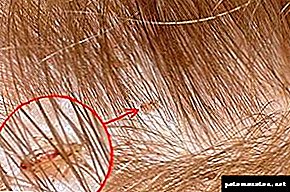 When identifying pediculosis, you need to take a comb with a frequent position of the teeth (as an option, you can buy a special comb at the pharmacy), as well as a sheet of white paper (for a printer or a school double unwritten sheet in a ruler or cage).
When identifying pediculosis, you need to take a comb with a frequent position of the teeth (as an option, you can buy a special comb at the pharmacy), as well as a sheet of white paper (for a printer or a school double unwritten sheet in a ruler or cage).
Next, you should tilt your head slightly forward and start combing the parasites. The sheets will begin to fall grains or flakes that resemble dandruff. They are on the background of the paper may look slightly grayish. Try to flatten the grain, squeezing it between the nails (fingertips for this procedure are too soft and the study will not work). If during a crush a click (crackling sound) is heard, it means that this grain is a nit, and this means that there is no longer any doubt that there is a louse on the head.
Prolonged damage to the head lice of children in the absence or inadequate treatment can provoke negative consequences - the occurrence of severe infectious diseases, since the affected areas on the skin are open gates for bacteria and microbes to enter the bloodstream and infection of the whole organism with them.
A common companion of pediculosis is lymphadenitis (swollen lymph nodes of patients in the process of palpation) of the occipital region and neck. The skin in areas of scratching is predisposed to suppuration, tangling of hair, which become prone to the formation of tangles.
What to do when detecting pediculosis
So, you have found a louse on the head of a child or someone from the household, or in yourself. So what to do to get rid of them?
Lice can be disposed of at home. To do this, combine mechanical and chemical methods.
Scalp treatment can be carried out with antiparasitic drugs purchased at a pharmacy. It can be:
- Spray Pax, Pair Plus,
- shampoo "Malathion", "Itaks", "Phenotrin",
- bottles with solutions "Medifox", "Nittifor".
Antipedikuleznye funds for the most part are composed of permethrin - an active substance that is a powerful poison for various insects, including for lice. However, it is completely harmless to the human body. Simultaneously with the application of chemical drugs to the scalp, it is necessary to simultaneously comb lice and nits from the hair using a rare comb or special device mentioned above.
Frequent wet cleaning with pest control is also added to the fight against insects:
 The last two products are diluted in water. Also pillows, bed linen, blankets and other soft things (blankets, sofas, armchairs) are treated with A-PAR substance. This drug is more preferable because it has already proved its high efficiency: the results after its use can be observed the next day. To relieve inflammation from the scalp and remove residual itching, it is recommended to rinse the head with decoction of anti-inflammatory medicinal herbs:
The last two products are diluted in water. Also pillows, bed linen, blankets and other soft things (blankets, sofas, armchairs) are treated with A-PAR substance. This drug is more preferable because it has already proved its high efficiency: the results after its use can be observed the next day. To relieve inflammation from the scalp and remove residual itching, it is recommended to rinse the head with decoction of anti-inflammatory medicinal herbs:
What to eat
There is no nutritional process in nits, since this is only the stage of development of the larvae, which is in a protective shell. For the same reason, the nit can not bite. Only lice bite themselves, causing the same sensations as when biting any insect that feeds on blood. When pediculosis (lice infestation) occurs in children, the bites are often perceived by parents as an allergic reaction to a product. What are the bites of lice, vivid photos you will find on our website.
Period of development
 On average, it takes about a week for a larva to emerge from the capsule, which is also called the incubation process. Its speed is strongly influenced by temperature.
On average, it takes about a week for a larva to emerge from the capsule, which is also called the incubation process. Its speed is strongly influenced by temperature.
An increase in the incubation period occurs when the air temperature is above 40 degrees Celsius, or below 22 degrees Celsius.
The period of formation of an adult individual from the larva usually takes about 15-30 days. From its inception to the end of its existence, a louse has only 4 stages of development.
- Egg.
- Larva.
- Nymph 1 and 2 order.
- Adult mature individual.
After the larva hatched from its capsule, the first meal, will occur after a very short period of time - in the first couple of hours. Two days after it, the louse is able to produce the first offspring of nits.
What is different from the nit lice
The main difference between nits and lice is that they are different stages of development of the same parasite. A nit is an embryo - the egg of the parasite, and the louse is a further developmental stage.
Based on this, it can be argued that they differ from each other in their appearance and manner of feeding. A nit looks like a small capsule of an oblong shape, the louse is a small insect that feeds on the carrier’s blood, unlike its embryo, the first food intake, which occurs only some time after birth.
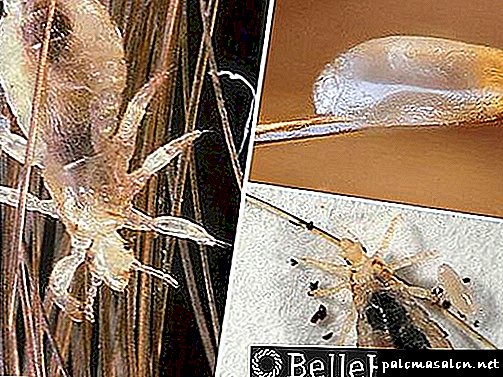
How to distinguish dandruff from nits
In order to be able to distinguish dandruff from nits, you should first analyze these two concepts in detail. What are the nits, was discussed in the chapters above. So what is dandruff?
Medical specialists call dandruff a pathologically abundant detachment of the skin of the scalp. This phenomenon is caused by the consequence of the disruption of the functioning of the sebaceous glands. Exfoliated skin covers the hair along their entire length, but most strongly accumulates at the root part of them. Much more noticeable is dandruff on the scalp of dark colors.
Particles of exfoliated skin are showered from any touch, be it a hand or a comb. This disease is not contagious, provided that the cause is not an increase in the number of pathogens. About the causes of dandruff on the head of a woman, read our website.
Both dandruff and nits cause the same symptoms - an unpleasant itching of the scalp. If it is caused by dandruff, then the feeling will disappear after a light scratching. And in order for itching to disappear during a head lice, more often than not, people tear off their skin to blood.
Pathologies and location in the head area differ from each other:
- The most common habitat for lice, and subsequently their offspring - nits, are those areas of the head where the temperature is higher. These places are the back of the head, forehead and temples, which are primarily examined by a medical specialist. As a rule, they are located at a distance of 10-40 mm from the scalp.
- Dandruff detachment occurs at the time of combing hair, with a light touch of the head with his hands or garments. Most of the detached particles are in the area of the crown. Due to the ease of removal from hair and skin, dandruff is visible even on the shoulders of a person, especially under the condition that he is wearing dark-colored clothing.
 In order to be sure of the diagnosis, a survey should be carried out in good bright light using a magnifying glass and a comb with frequent teeth. There are a number of signs that distinguish nits from dandruff.
In order to be sure of the diagnosis, a survey should be carried out in good bright light using a magnifying glass and a comb with frequent teeth. There are a number of signs that distinguish nits from dandruff.
- Capsules of identical shape and size, while scales of exfoliated skin, differ in parameters.
- With good vision, or provided that the increase is quite strong, it is possible to notice the stains on the parasites, as well as the presence of larvae inside the capsule. Dandruff does not have a uniform bulge.
- The sound is also one of the signs, because when you press on the nits there is a characteristic click. When pressing on dandruff, no sound occurs.
- The number of white bodies also becomes a distinctive factor. Provided that the pathology is dandruff, then there is a lot of scales all over the head, as well as along the entire length of the hair. The number of nits increases gradually.
We recommend to read: how to distinguish dandruff from nits in the hair.
An important point! Only a neglected form of pediculosis implies the location of eggs over the entire surface of the head and for the most part the length of hair.
How do they appear on a person’s head?
The most common way of developing pediculosis is getting close contact with an infected person.and wearing the headgear of such a person or using his comb.
Close contact for the appearance of lice and nits are those actions of an infected and healthy person, in which their heads are touching. For example, children are characterized by joint games, after which lice are distributed instantly throughout the company of children.
Nits cannot arise from nowhere, as they are a consequence of lice infestation, which can only be transmitted from another person. Also, even if one capsule gets on the head, which is very rare, the disease will not be able to develop, since there will simply be no conditions for reproduction.
Capsules appear on the scalp almost immediately after several lice fall on it, as the process of reproduction begins.
Details where lice come from a person, you will find on our website.
 How to determine that wound up nits? Symptoms of the disease, as a rule, are invisible immediately after its appearance, since they are not strongly pronounced and the person simply does not consider it necessary to pay attention to them. Despite this, it is possible to detect signs of lice in the early days of infection.
How to determine that wound up nits? Symptoms of the disease, as a rule, are invisible immediately after its appearance, since they are not strongly pronounced and the person simply does not consider it necessary to pay attention to them. Despite this, it is possible to detect signs of lice in the early days of infection.
There are the following symptoms of infection:
- Persistent itching that does not go away even with a strong scratching of the skin.
- The presence of bites, since the entire diet consists of human blood. In order for bites not to heal, parasites introduce a special secret that interferes with the process of blood clotting.
- Light tingling, like a mosquito bite. The sensations of a mosquito bite and a bite of a louse are the same.
- The presence of white Taurus in the root of the hair.
Of the above symptoms, itching is most noticeable. Most often, it is he who becomes the reason for seeking medical attention or conducting a thorough examination of the head at home.
Are there any nits without lice
Such a case is possible, but very rarely. Detection of empty nits capsules, where there are no living individuals, makes you think about the situation well. The answer to many questions will be that measures have been taken to combat head lice, either on purpose or by lucky chance.
Living individuals on the head are absent, as they died as a result of any impact. One of the types of such exposure is painting with a mixture containing hydrogen peroxide, or hair lightening, as a result of which peroxide killed lice and nits.
Treatment methods
 There are several ways to get rid of skin nits, lice, and, respectively, associated with the disease symptoms, the most unpleasant of which is the constant impassive desire to scratch your head.
There are several ways to get rid of skin nits, lice, and, respectively, associated with the disease symptoms, the most unpleasant of which is the constant impassive desire to scratch your head.
- Mechanical way - combing with a specialized comb with a frequency of teeth of 0.2-0.3 mm. This method is the most secure. This comb can be purchased at any pharmacy.
- Shampoo use will have a pretty strong effect, removing a significant part of the parasites, and will be an excellent preparation for the subsequent combing.
- After combing and rinsing with a special shampoo, part of the nits can remain on the hair. In this case, the removal process can be continued with the help of chemical drugs. When deciding to use only pharmaceutical drugs, disposal can occur in several applications. They will help get rid of pediculosis at home.
Chemicals should not be abused, as they can cause significant harm not only to parasites, but also to the human hair and skin.
Popular remedies for lice and nits:
- drug Permethrin from lice and nits, reviews,
- instructions for use hygienic,
- composition and principle of action of the drug D-95,
- how to properly apply medifox against lice and nits,
- Neath Free product line against lice and nits
- The best remedies for the treatment of pediculosis in children.
What do lice look like on a child's head?
Lice are long-known and, unfortunately, common parasites in humans. Head louse settles in the scalp and gives a lot of inconvenience, both children and adults. The parasite does not choose a habitat by age, position in society, so the problem can affect any of us.
The problem does not apply to the lower social strata of society, as it is not rarely seen in people from wealthy families who do not neglect the rules of hygiene. But nevertheless children suffer most from pediculosis.
Infection options
Lice infestation occurs through the migration of parasites from one person to another. At the same time, lice do not know how to fly or jump, but are able to move very quickly, which contributes to the rapid spread of the problem.
Modern medicine identifies several ways to infect lice:
- Visiting places where there is a large crowd of people, among which may be carriers of parasites.
- Visit public pools or beaches.
- A visit to the sauna, in which there are people with pediculosis.
- Public transport.
- Exchange of clothing, especially headgear with a person who is infected with lice.
From the moment of infection, it takes about a week, when the patient observes the first signs of pediculosis. They can be seen only in 1.5-2 weeks. This is another reason why the problem is so common in children's groups.
Many children are carriers of parasites, completely unaware of this, since they do not yet observe characteristic signs due to a recent infection.
How to recognize pediculosis
In order to timely determine pediculosis in a child, you need to pay attention in time to the slightest complaints of itching in the hair part of the head. Pediculosis has specific symptoms that make the problem recognizable.
So, to suspect pediculosis is possible in the presence of the following signs:
- Severe itching of the scalp, and not necessarily itching observed in the scalp.
- The appearance of irritation, papules or erythema on the scalp.
- Sleep disturbance, anxiety of the child due to constant discomfort in the hair.
Observing such symptoms, it is necessary to inspect the head for the presence of parasites. Recognizing an insect is not difficult, even if you have never before encountered such a problem, you have no idea how to distinguish it from other insects.
What do lice and nits look like on a child's head?
On examination of the head, it is not possible to notice the louse immediately, especially if the infection has recently occurred and the population is not too large. Recognizing the parasite is easy.
Its main features:
- Gray or whitish louse.
- Torso length not more than 6 mm. The shape is elongated, so the insects are a bit like ants. Only the belly of the lice is more massive.
- It has six legs, which are brought forward to the body.
- The insect has no wings.
Parasites move very quickly, so most doctors when examining the head for the presence of head lice are guided by nits. It is much easier to find them.
You can identify nits by the following features:
- Yellowish white small balls attached to the hair.
- Mostly females lay nits at a distance of about a centimeter from the scalp.
- The size of nits is tiny, the diameter is not more than 1.5 mm.
- It is difficult to remove the nits from the hair; they are well attached to the hair with a special compound that releases the louse.
- When you click on the nit heard a characteristic click.
Small nits of white color can be confused with dandruff. But unlike eggs, lice dandruff is easily removed from the hair and does not emit cod when pressed. In order to properly recognize the problem, we recommend that you familiarize yourself with the photo of the lice in the child’s head.
That is why doctors advise to study the characteristics of the parasite. The ability to identify the head louse allows you to diagnose pediculosis much faster, which helps to get rid of the problem as soon as possible.
Useful videos
How to remove the lice and nits on the hair.
How to get rid of nits: treatment of the head, combing, products, shampoos.
Lice in hair: treating a disease
In order to maintain your health, you must not only eat right, but also follow the rules of hygiene. Otherwise, parasites will start on your body and cause a lot of problems.
The main cause of its occurrence is lice. These insects can be of three types:
- head louse
- cootie,
- pubic louse
Nowadays, this disease continues to be relevant. On examination by a dermatologist, pediculosis is often detected. Those people who have to come in contact with a large number of people are more susceptible to this disease. Especially often this disease is found in kindergartens and schools. You can catch them:
- in trains when using non-sterile underwear,
- in baths and saunas.
In most cases of pediculosis, the main cause of this disease is head lice.
Methods of diagnosis of diseases
The diagnosis of this disease is quite simple. All that is required from the dermatologist is to carefully examine the patient's hair and scalp.
When a person finds head lice, then to eliminate this problem, people usually resort to folk remedies that are not effective in the treatment of lice. Kerosene, tar soap, vinegar - these funds are used today extremely rarely.
Medications
Modern medicine currently offers a large number of drugs that help in the short term to get rid of lice. Using them in accordance with the instructions, you can quickly remove the head lice.
For the most part, anti-head lice products are special sprays and shampoos. If we talk about the most common, then select the following:
- cemeric water
- Phenotrin,
- Shampoo
- 5% sulfur ointment,
- boric ointment.
The drug for getting rid of head lice is prescribed by a dermatologist. Before you use any of these drugs, you must carefully read the instructions.
In particular, such drugs are not recommended:
- pregnant
- small children
- allergy sufferers
- people who have airway pathology.
After each use of a medicine prescribed by a doctor, you should comb your hair with a metal comb. Use should be an accessory that has rare teeth.
Since not all nits can be destroyed during the treatment with the drug, for the effectiveness of treatment it is necessary to additionally remove them from the head with your hands.
However, this will take more time. If you use a plastic comb to comb hair, it will not help to separate the nits from the hair shaft.
In order to make this task easier for you, you should put olive oil on your hair before using the comb. This product helps to more easily cope with this task. In addition, it has anti-inflammatory and wound-healing effect.
If you do not use toxic drugs for treatment, you can apply conditioner to your hair, and then comb through each strand with a comb. It is necessary to do it on 1, 5, 9, 13 days.
Faced with pediculosis, many shorten hair. This is not worth doing, because the lice live at the roots of the hair. They do not attach to the hair further than 5 cm from the surface of the head. Having cured of this disease, a person should avoid visiting institutions with a mass gathering of people for two weeks.
What do lice look like in a photo? And how to distinguish head lice from other parasites?
Lice, parasitic on the human body, are divided into three groups: head, pubic and ward (otherwise linen). Each species has its own appearance and peculiarities of life; among them they can never be found. Therefore, the treatment in each case is different!
The most common type of lice, parasitic on a person, lives exclusively on the scalp, preferring to settle behind the ears, on the back of the head and at the neck.
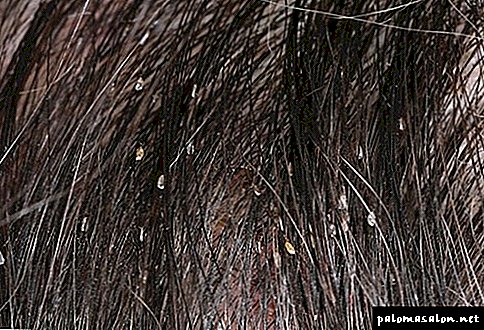 This is how lice look on hair.
This is how lice look on hair.
Head lice differ from their cousins, body and pubic lice, primarily in size: they are larger, adults can reach 4 mm in length. Due to its large size, head lice can be easily distinguished in the hair when viewed. In the normal state, the body of the louse is transparent, after the bite, the blood of the carrier stains it red.
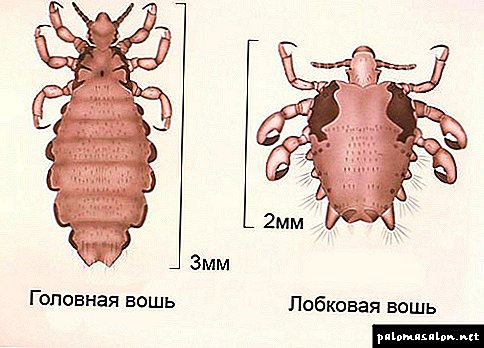 The differences are striking
The differences are striking
Lice do not have wings. The little body of the head lice is elongated, slightly widened downwards, with uneven protuberances along the edges. The narrow, oblong shape of the body with the legs pointing forward and to the sides allows them to easily move through the hair.
 And this photo is in real size.
And this photo is in real size.
Insects give additional tenacity and maneuverability to the insects at the edges of the abdomen and rounded limbs in the form of claws. Eyes lice underdeveloped. In order to navigate in space, they use a rather long antennae, located in front.
 Adult louse in a larger view
Adult louse in a larger view
Lice larvae (called nymphs) are smaller — about 0.8 mm in length. They have a light tint of the calf, so the first couple of weeks after infection (until the larvae grow), it seems that white sand or dandruff in the hair. But with the passage of life they darken, feeding on the blood of the wearer, and grow in size.
 Nits are so small that they can not be seen in the hair
Nits are so small that they can not be seen in the hair
Nits (lice eggs) of all kinds look about the same. Their color ranges from white to light yellow. In shape, they resemble a drop. Females of lice leave them right on the hair (more often - at the very base of the hair), hooking them with a sticky secret, which very quickly hardens and provides a secure attachment of the nits to the hair.
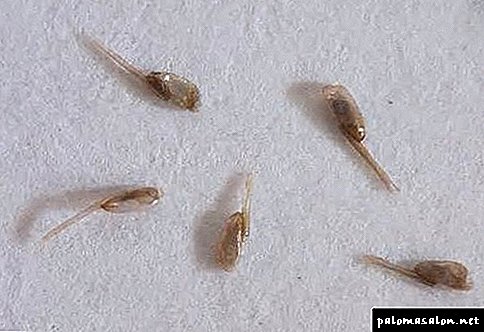 Nits in a magnified form
Nits in a magnified form
The life cycle of an individual is about one and a half months. The first 5 days the louse spends as nits (eggs), then 8-9 days as a nymph (immature larva). In all her life, a mature female lays up to 300 nits.
How to treat head lice? For a start, I advise you to try hellebore water.
Ploshchitsy is the second name for pubic lice. They inhabit the groin of the groin, armpits, eyebrows and eyelashes.
Pubic lice are largely different from the head - both in appearance and behavior, so in vivo they do not interbreed.
 Pubic lice
Pubic lice
In appearance, the pubic louse looks like a small crab: it has a flattened diamond-shaped body, more massive than that of a head louse, legs. Body color varies from beige to brown.
The antennae on their head are not directed forward, as in head lice, but to the sides, since they often move along the surface of the skin, rather than climbing along the hair.
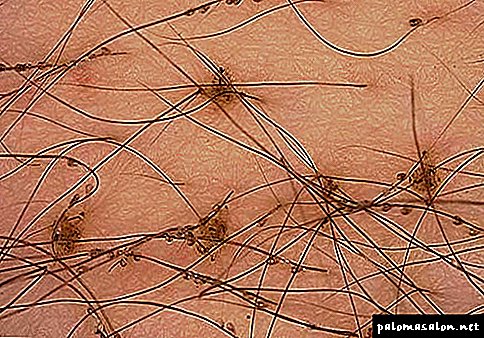 So they look on the hair in real size. Hair is also littered with nits (eggs)
So they look on the hair in real size. Hair is also littered with nits (eggs)
Pubic lice nits have certain differences from head or body lice nits: more pointed, spindle-shaped and darker in color. Pubic louses catch eggs at the very base of the hair, practically on the skin.
The allocation of a separate type of lice conditionally: they are derived from the head, only their habitat is different: most of the time they spend on human clothes, clinging to the fabric, moving to the body only for blood supply.
Their favorite habitats are clothes folds and pockets. Body lice can only live in dirty clothes, so they usually infest the homeless, the soldiers in long crossings, in any unsanitary conditions.
The only difference is the larger, spindly abdomen, which gives them a resemblance to fleas. However, body lice do not know how to jump, so confusing them with fleas is almost impossible.
The bites of body lice are the most noticeable. Since hair is not very pronounced on the body, it is very easy to recognize the signs of bites. They resemble mosquito bites: reddened bumps on the skin that are very itchy. Biting body lice often causes severe allergies.
Lice in the hair of children and tips on how to deal with this problem.
Pediculosis, according to the Ministry of Health, is distributed among approximately 2% of the total population of the Russian Federation. Most of the infected are children. Where do lice come from? They are infected from other children, for example, in school or kindergarten.
Baby age does not matter. The main thing - the presence of hair, at least short.
The first thing you need to understand what "lice" and how they differ from the "nits." The first ones are parasitic insects that feed on keratinized epithelium and blood from the upper layers of the epithelium.
Nits are their eggs (although it is more correct to call them “cocoons”). They lay the females of several thousand pieces per day.
Of these, only 5-10% remains on the hair. However, even 2-3 nits on the head will be enough for a new colony of parasites to form there in a few weeks. That is why, in order to get rid of pediculosis, one should first of all deal not with the insects themselves, but with their cocoons - to destroy them is much more difficult.
The body consists conditionally of 2 parts - the head and back, which is connected by a narrowed transition. Mostly lice are found in the temporal lobe or on the back of the head (there is the thinnest skin).
But the nits are small whitish cocoons, up to 1 millimeter in size (most often - 4-6 microns). They are attached directly to the hair. Very durable, not washed out. When squeezed - burst with a characteristic "crack".
It is also worth mentioning the so-called "lingerie" lice. In children, this is a great rarity. Unlike the ordinary, these parasites live in clothes, not hair.
Visually very similar, but smaller. They lay their nits in the fabric (only if it is natural).
The reasons for their appearance on the head and the way of infection
Lice can be contaminated only by contact. That is, by direct contact with the infected or with his personal belongings (in particular, clothes, hairbrushes, barrettes, hair ties, underwear).
By the way, recent studies by scientists and the WHO (World Health Organization) prove that mainly owners of not long hair, who often wash their heads (at least 3 times a week), suffer mainly from pediculosis.
Based on this, lice prefer clean hair without excess sebum.
How to recognize: the symptoms and signs of pediculosis in a child
A clear symptom of pediculosis is irritation of the skin of the scalp, as well as persistent severe itching (mainly in the temples, behind the ears, on the back of the head).
But these symptoms are consistent with fungal infections, and even allergies. That is why a visual examination of the scalp is performed to make an accurate diagnosis. Determine the presence of lice in nits on the hair.
How to detect lice and nits in a child? The easiest way is to use a special small comb. His teeth are so close that lice and even nit cannot crawl through them.
Accordingly, they can try to "comb out" the parasites. If at least one insect or egg is found in this way, then this is a guarantee that the child already has pediculosis.
By the way, you should search for lice in a child only in disposable medical gloves. Only in this way can you protect yourself, and subsequently your loved ones, from infection.
Do I need to go to the doctor
The question arises: “What should I do if a child has lice?” Pediatricians are involved in the treatment of pediculosis. But to seek medical help is not necessary.
The main thing is to isolate the child and not allow him to stay in groups (in order to prevent infection of others). And how to save a child from lice? To do this, you can use any of the available pharmaceutical pesticides, such as dust shampoo or soap.
In just 1-2 shampoos in this way, you can completely get rid of lice, but for the next 5-7 days, prophylaxis and daily visual examination of the scalp are introduced (this can also be done independently).
But if the child also has inflammation and flaking, you should still consult a doctor. At least in order to assure themselves of the absence of an allergic reaction or the addition of an infection.
How to deal with pediculosis in children at home? By law, the most "popular" method of treatment of pediculosis is the most common table vinegar.
By the way, the doctors themselves use it in practice, since such a tool is absolutely safe, it can be applied even to the youngest children. And in terms of effectiveness, it is not inferior to pharmacological drugs against lice.
How to remove with vinegar
First of all, vinegar is diluted with water in a ratio of 1 to 1 (in the end, you get a 4.5% solution).
Then - moisten the obtained solution with hair, covering it from above with a towel. After 20 minutes, wash your head in the usual way (preferably with soap without preservatives and dyes).
It is worth considering that vinegar does not affect the nits. However, it dissolves the adhesive substance with which they are attached to the hairs.But the lice themselves from the solution become lethargic, fall off even with the usual rinsing of the head under running water.
The next day, the procedure should be repeated again. The main thing is to very well comb out the hair with a special comb (sold in any pharmacy).
How many times do I need to wash my hair with vinegar? Doctors recommend at least 3 times, then daily carefully examine the hair for the presence of nits. Even if there are several of them left there, the head lice will soon return.
If vinegar for some reason did not help or lice appeared again, then you can use a radical method of treatment - shave it well. Without hair lice die already after 1-2 days.
What to do after treatment
After treatment, all the personal belongings of the child, be it bedding, T-shirts, jackets, T-shirts, must be boiled or washed at a temperature of 80 degrees or higher.
If a child has things that neither wash nor steam generator does not process, then it is recommended to fold them in a sealed bag (with a zipper) and hang out either in the cold or in the sun.
Lice, oddly enough, very afraid of lack of air and low temperature. In the future, things simply vydrasit or rinse in cool water.
But all sorts of accessories for hair care (hairpins, combs) are best treated with vinegar or a special pesticide (sold in a pharmacy). Unpleasant smell from such a "disinfection" disappears quickly enough.
What preventive measures are often used
Unfortunately, there are no effective measures to prevent head lice today. Anyone can infect them, regardless of their status, grooming, age and personal hygiene.
But this, as practice shows, is not enough.
And what can parents do? First of all, at least 1-2 times a month to conduct a similar inspection, and secondly, to monitor the child's behavior.
It does not hurt him to personally tell about this disease. And the main thing is to explain that lice is not a shameful thing.
Unfortunately, at the moment, many have such an erroneous opinion. If he actively scratches his head, then, most likely, he already has parasites.
It is impossible to prevent infection, but it is up to everyone to detect the disease in a child in a timely manner and take appropriate measures to eradicate the parasites.


 round shape, like a small ball,
round shape, like a small ball, Carefully look at the scalp for the presence of lice bites that look like pinkish or red vesicles. Most often they can be seen above the ears and in the region of the occipital part.
Carefully look at the scalp for the presence of lice bites that look like pinkish or red vesicles. Most often they can be seen above the ears and in the region of the occipital part.